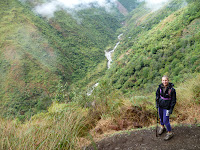
There are two big mysteries in South America - how did the Inca people carve such glorious temples out of solid stone? and why does everyone think you have to book months in advance for Machu Piccu and Galapagos tours?
The answer to the first question has to be blood, sweat and ingenuity. The Inca's ground thin holes into huge pieces of rock and placed thin strips of dry wood inside, then added water. This caused the wood to expand and the rock to, eventually, break in a perfect line.
We only found the answer to the second question after surfing the net for the best deals only to find trips costing in excess of $600 a week! After talking to a girl in Cartagena, Colombia who told us she paid just $180 in March (low season) we decided to see what we could find on the ground - trip or no trip.
If you don't mind winging it and picking your trip by visiting all the agents on one street, you DO NOT HAVE TO PAY CRAZY PRICES MONTHS IN ADVANCE, this is a myth brought on by international agents. In the Mariscal, Quito Ecuador, you can get week long trips to the Galapagos from $400 and they have every class available. In San Blas, Cuzco Peru, you can find an Inca trail walk for $350 and a Salcantay glacier 4 day 5 night trip for just $170 if you have a student card. No matter what you pay, advance or not, on the whole its the same operators who take you out. It's the high season now and everyone has trips going the next day, it's easy.
In Cuzco, Maudie organised our trip as I was struck down with mild altitude sickness brought on by the 3400m level and an over indulgence in the previous week on rum, cerveza and Pall Malls.
We set off at 4am and met up with our group for the 5 day, 4 night trek across the Andes in the footsteps of the Incas. After a three hour bus ride we were set loose and on the trail. We had with us two great Peruvian guides, 2 girls & 2 guys from Holland, Julia from Brazil, Kevin AKA Jesus from the USA, Clementine from France, Alexandra from Poland and Jose & Rafael from Sao Paulo.
The walking was brutal, 8 hours a day at a fast pace, we marched up to the first base camp (Soraypampa) below the summit of Salcantay at 4600m. On the exposed plateau, as the first night fell we saw the night sky in a totally new light - you could actually see dusty galaxy's surrounded by bright shining stars! And it was so cold that spit from brushing your teeth actually froze on impact on the sink! - sleeping wasn't exactly easy.
The next day, full of warm coca tea, we trekked up the steep dry cliffs to Salcantay. There, as a group we made a pledge to the Inca gods and then moved on our way to the warmer climes of the cloud forest below.
The next two days were spent trekking through jungle and primary forest, huge mountains covered in trees and bamboo surrounded our vision. When you though the mountains couldn't get higher, the clouds shifted and revealed a whole other layer of summit.
As we came down the side of the mountain 'Llactapata' we were greeted by the sight of a huge waterfall coming out of an impossibly high mountain. We asked ourselves, how does a waterfall that high containing that much water exist? the answer was hydroelectric - it was the overflow from the turbines built into the other side of the mountain.
We approached Agua Calientes, the town at the base of Machu Piccu, and silently reflected on our 100km journey as we walked the river bed some 700m below the Inca city found by Hiram Bingham of Yale University 100 years earlier. My feet were in bad shape, we carried heavy bags, and it was raining, but our spirits were at their peak in anticipation.
Over 4000 people visit Machu Piccu every day in the high season, the smaller site of Huayna Piccu (the lookout rocktower gazing over the site) cannot cope with all the visitors so they give only 400 tickets on a first come basis. With this in mind our group (and everyone else in Agua Calientes!) set off early at 3am to get in the queue for the 6am opening.
There are 1900 stone steps leading from the river to the gates, they where built buy the Inca's out of granite and are as good today as they have ever been. My feet were in bits, but a mix of ibuprofen and paracetamol helped take the edge off it and we climbed hard - getting to the top just before 5am. Numbers 17 and 18! We were hot, sweaty and incredibly proud of our achievement, but within minutes the cold had overcome us so a quick t-shirt change and ham rolls with our friends helped the last hour fly by.
On entering we found Machu Piccu to be an incredible experience, as the sun slowly rose the city came alive, shadows were cast and the clouds danced across the sky. Every minute was different, it was incredible. It is incredible to see what was built in 1400AD and abandoned a century later to ensure it was kept safe from the Spanish conquistadors. The stonework is perfect, the terraces provide food, they have an aqueduct water system and the locations is designed around the sun, earth, moon and sky.
It was a challenging journey that has taught us as much about ourselves as it has the inca people... I am looking forward to putting on some cramp-on's and trekking higher in Bolivia!



















































